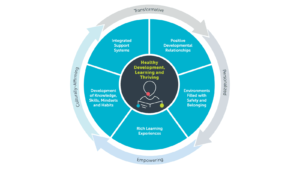Education Standardization: Essential or Harmful?

In my previous post, I described how much of the standardization that exists in our current system of schooling is harmful to students and should be eliminated, but made the argument that not all standardization is harmful – that, in fact, in some cases it is essential to enable innovation and transformation. Today I will discuss some areas where standardization is possible, some advantages and disadvantages of each of these, and my rationale for whether standardization at this level is helpful or harmful.
Standardized level, pace, and path of learning
- Advantages
- Ease of implementation at scale
- Meets expectations of educators, community, and politicians
- Already implemented at scale and doesn’t incur the significant risks associated with change
- Disadvantages
- Inefficient for any given student’s learning
- Contributes to disengagement among students
- Conclusion: HARMFUL – The most obvious and concrete problem with standardizing level, pace, and path is illuminated by how poorly that serves students who are far from “average” in any given academic area. It isn’t news that students who “get” the material quickly often disengage due to boredom and students who struggle disengage due to hopelessness. Solutions that help mitigate the issue, such as problem, project, cross-disciplinary, or inquiry based learning do so by beginning to break down the assumptions about level, pace, and path yet require tremendous investment of resources to overcome a structural problem that, perhaps, needn’t exist at all.
Standardized curriculum
- Advantages
- Standardized curriculum supports some level of equity by ensuring all students have access to curriculum which has been found adequate by representatives of their communities
- Teacher-proofing through scripted curriculum reduces harm that can be done by poor teachers
- The current system of curriculum adoption with highly invested and influential incumbents (as well as hopeful wanna-be’s) will support continuation of status quo, again not incurring the risks associated with change
- Disadvantages
- Standardizing curriculum severely limits the opportunities for students to learn by enforcing a one-size-fits all curriculum
- Curriculum standardization de-professionalizes teaching by marginalizing the professional judgment, experience, and skill of teachers (to the degree that the curriculum is scripted and prescriptive.)
- Standardization here tends to shift professional practice towards content coverage and away from deep understanding
- Conclusion: HARMFUL – When curriculum is used as a tool (or one of many tools) by a skilled teacher in helping students achieve meaningful outcomes, it counts as highly useful. However, as is far more often the case, when a prescribed curriculum imposes exactly one correct way (generally based on content-transfer pedagogy) for students to achieve those outcomes, it dooms many students to failure where alternative approaches may help them to succeed. It also creates a sort of “learned helplessness” among teachers who are trained to cover curriculum rather than find the best ways for a particular student to learn. Curriculum is an area that can benefit tremendously from innovation – a sure sign that it is a poor area for standardization.
Standardized assessments
- Advantages
- Standard assessments can be a useful tool for highlighting issues of equity, making it possible to compare the achievements of large student groups by race and socioeconomic status and to identify systemic disparities.
- Standardized assessments provide parents and students with insight with respect to one measure of a school’s track record in student achievement as compared with other schools locally, nationally, and internationally.
- It is possible for standardized assessments to provide feedback loops for schools regarding how students are progressing that can be used to improve schooling.
- Disadvantages
- High quality assessments are very expensive to administer at scale and so are generally discarded in favor of multiple-choice tests that are relatively narrow and of limited utility in gauging the achievements of an individual student.
- The existence of standardized, summative tests is leading our political and educational system to fallaciously believe that what we need to understand about student growth can be distilled down to their performance on a specific test of knowledge and procedures on a given day. This belief has led to the inappropriate use of mediocre high-stakes summative testing as a proxy measure for individual student success.
- The high-stakes nature of summative testing biases schools towards focusing on test success at the cost of other learning that may better serve students in the long run. Rather than serving as an indicator of overall student learning, the test becomes the end goal in itself.
- Conclusion: DANGEROUS AND HARMFUL (for now) – My deep concern with standardized testing is contextual rather than intrinsic and derived from two key issues:
First are the relative paucity of quality standardized tests and the immaturity of scalable standardized testing on many levels. There is interesting work happening in this area and I am hopeful that we will eventually arrive at a point where assessment is rich, deep, wide, authentic, useful, and meaningful for a single student (not just large populations in aggregate.) As innovation in the area of summative testing continues to move forward and improve, it will be critical to take advantage of better assessments, such as those associated with the common core, while recognizing their limitations and continuing to evolve those assessments until their limitations are overcome or the use of the results is consistent with whatever limitations remain.
Second is the inappropriate use of data with limited validity and scope. Again, there is interesting work happening here – perhaps we will find ourselves with rich digital continuous assessments that are used to measure student progress towards mastery that offer meaningful and scalable ways to gain insight into student growth. At that point, standardization of assessment would move from harmful to useful, giving students the power to understand how their effort has been rewarded and to judge where to put their effort to continue to progress.
I remain optimistic that the science of assessment will evolve rapidly and for the better in an era of big data. Formative assessment will no longer consist of quizzes and midterm exams but rather become a side effect of students interacting authentically with great problems and challenges in a digital environment. Data about approaches that a student tries, how the student persists in the face of challenges, where the student turns for deeper understanding will, someday soon, be able to drive feedback loops that deeply inform a teacher’s, parent’s and student’s understanding of a child’s learning. Summative assessments will become a light-touch snapshot that provides some comparative insight between populations but that doesn’t inappropriately usurp the roles that ought to be filled by rich, continuous, embedded assessments, by meaningful measures of student growth, or by thoughtful evaluation of teacher performance by professional communities of practice.
However. Until those advances are realized, the current context and limited capabilities of standardized tests generally lead their use, in practice, to be counterproductive, with harmful unintended consequences which are potentially outright dangerous to our system of education.
Standardized expectations
- Advantages
- Standard expectations on what students should know and be able to do on completing public education supports some level of equity.
- Standard expectations make it possible to shift the focus from the “process” of teaching and learning (did everyone follow the scripted curriculum?) to the “outcomes” (what do students know and what can they do?) regardless of the path or pace taken to achieve mastery.
- Standardizing at the level of expectations makes it possible to innovate at the level of personalization. There is a strong need for innovation in the “how” of teaching and learning, while standardization of expectations provides sufficient structure to evaluate pedagogy, culture, interventions, resources, technologies, and other elements of schooling with respect to how well those standards are met.
- Standardizing at the level of expectations also strongly supports market-driven innovations for teaching and learning by consolidating the market and making it viable for truly innovative and useful new products to reach a wide audience.
- Disadvantages
- If expectations are standardized at a “rote performance” level, schools are biased against spending time and energy on teaching and learning that goes beyond that level.
- If expectations are standardized to prepare students for work and life as well as college courses, on the other hand, the expectations are likely to outstrip our ability to assess outcomes against them.
- Conclusion: USEFUL – The past several years have seen a nation-wide recognition of the dangers and inadequacies of limited, rote-performance standards of what students should know and be able to do. The resulting Common Core Standards and more recent Next Generations Science Standards have successfully shifted the focus of student outcomes to practical, cross-disciplinary, higher-level performance that gets at deep understanding rather than simple rote performance. The challenging part of using these standards comes in determining the role of assessments (particularly digital assessments) and the use of data in feedback loops to improve instruction.
Because the tools to measure outcomes, (indeed, the very metrics themselves) are still immature, data-driven decision-making against complex performance within the adaptive systems that are modern work-places and (ideally) places of learning, is likely to very quickly lead us astray – as though we were blindly following a compass that had lost true north, and ignoring the landmarks even though we can see them. Fortunately, though, with high quality standards to set our destination, we can rely on the judgment of experienced human educators who can recognize the “landmarks” of learning to make decisions about whether we are on course or not. The immature, but evolving, data science of education can and should inform that human judgment and, in turn, itself become improved by the feedback loops resulting from that application of judgment and experience.
Standardized data formats and interoperability
- Advantages
- Standardized data formats enable sharing of data between educational applications, making it possible to provide a complete and coherent set of data regarding the learning of a given student in order to personalize that students learning, or to provide anonymized data back to educational software developers to help them rapidly improve the quality of their offerings, or to provide anonymized and aggregated data to scholars and researchers to help improve education science. In theory, well-structured feedback loops including student data could drive new innovations and improve learning on Internet time. Revolutionary!
- Disadvantages
- Standardized data formats and access can create opportunities for exploitation, through the deliberate or accidental revelation or commercial uses of private student information.
- Students may come to be defined (and therefore limited) by the necessarily narrow view created by the metrics and data chosen to be stored in standardized formats.
- Conclusion: ESSENTIAL and DANGEROUS – Students have the right to reclaim power over their education, to personalize their goals, paths, and pace and to be supported by informed, capable educators in doing so. This level of personalization requires students and their parents and teachers to have understanding and insight regarding their performance and the paths available to them for meeting their goals. Standardizing at the level of data formats and interoperability enables critical innovation to happen one level higher where software developers create maps, dashboards, or other visualizations that help students, parents, and teachers understand that student’s learning and build a personalized path towards mastery.
Further, making such data available to researchers opens doors for understanding learning that becomes qualitatively different from the kinds of research available prior to the advent of big data. The benefits are too great to ignore, but the dangers of putting student data in the hands of commercial (or even scholarly) entities are unacceptable until such time as we standardize mechanisms for ensuring student privacy.
Fortunately, there are leading organizations, such as InBloom and Amplify that are setting the precedent of ensuring, with world-class software security approaches, that student data stays within the district and that the judgment of educators, administrators, and parents are used to decide how and whether that data is shared. So, proceed with caution here, but do proceed.
Standardized (high) level of digital access
- Advantages
- If pegged to the level of access enjoyed by affluent students (24/7 Internet access via modern, personal devices) as opposed to a level designed for minimal equity (time-shared devices at libraries and schools), a standardized level of digital access is a necessary (though not sufficient) step towards reducing the digital access divide.
- Disadvantages
- There are significant costs to providing access for all students. There are even higher costs associated with the changes in culture and practice required to take advantage of an infrastructure that provides 24/7 digital access for all students.
- Conclusion: ESSENTIAL – The advantages, benefits, and power enjoyed by those who have 24/7 digital access versus those who don’t is dramatic and accelerating. Basic infrastructure supporting this level of access universally is not only a necessary (though insufficient) requirement for addressing both the achievement gap and the digital divide, standardizing at this level enables critical innovation at the next level up. Educators, at scale, will be able to innovate and evolve their practice to more student-centered models when they can rely on all students having acceptable levels of access. Commercial developers, foundation grant-makers, and scholarly researchers will be able to innovate in digital resources and practices that reduce achievement gaps when they can rely on their products being accessible to all students.
As will become increasingly clear over the course of the next several years, quality digital access is not only a question of academic achievement, but of social justice.
The decision regarding where and how to standardize is complex, ambiguous, and highly context-dependent. The question of whether the benefits outweigh the risks may be answered differently for different communities or classrooms and may depend heavily on how or whether the associated risks are understood and mitigated. The above list is hardly exhaustive, and I confess my opinion about some of these are in flux – changing as my understanding becomes more nuanced and as I learn more about how proposed standardization is actually evolving in practice.
Standardization is a polarizing issue due to its importance, its complexity, and its context-dependence. Answers require systemic approaches that consider the possible unintended consequences and potential exploitation of standards. I invite you to challenge my thinking, my assumptions, and my beliefs on the complexities of standardization. I also invite you to challenge your own and to add to this conversation.







0 Comments
Leave a Comment
Your email address will not be published. All fields are required.